The ozempic cost can vary significantly based on various factors, including insurance coverage, pharmacy location, and dosage requirements. Ozempic, a popular medication for managing type 2 diabetes, has gained attention not only for its effectiveness in regulating blood sugar levels but also for its potential weight loss benefits. This article will delve into the ozempic cost, factors influencing its price, and ways to make this medication more affordable for those who need it.
What is Ozempic?
Ozempic, known generically as semaglutide, is an injectable medication that belongs to the class of drugs called GLP-1 receptor agonists. It helps lower blood sugar levels in adults with type 2 diabetes by mimicking the effects of a hormone that stimulates insulin secretion when blood sugar levels are high. Besides its primary function, ozempic has also shown promise in aiding weight loss, making it an appealing option for many individuals struggling with obesity.
Understanding Ozempic Cost
When discussing the ozempic cost, it’s essential to consider the medication’s retail price without insurance, which can be quite high. As of recent reports, the average retail price of Ozempic is approximately $900 for a monthly supply. However, this price can fluctuate based on factors such as:
- Insurance Coverage: Many insurance plans cover Ozempic, which can significantly reduce out-of-pocket expenses. It’s crucial to check with your insurance provider to understand your specific coverage details.
- Pharmacy Discounts and Coupons: Various pharmacies offer discounts or coupon programs that can lower the ozempic cost. Websites like GoodRx can help you find the best prices available at local pharmacies.
- Dosage and Prescription Amount: Ozempic is available in different dosages, and the prescribed amount can affect the overall cost. Patients are typically prescribed either a 0.5 mg or 1 mg dose, with the higher dose potentially resulting in increased costs.

How to Reduce the Ozempic Cost
Navigating the ozempic cost can be challenging, but there are several strategies you can employ to minimize your expenses:
1. Explore Insurance Options
Before starting Ozempic, contact your insurance provider to determine what coverage they offer. Some plans may have specific requirements, such as prior authorization or step therapy, which can affect your ability to obtain the medication at a lower cost.
2. Utilize Prescription Discount Programs
Several organizations offer prescription discount programs that can help lower your medication costs. Websites like GoodRx, SingleCare, and NeedyMeds can provide coupons that offer significant savings on your Ozempic prescription.
3. Consider Patient Assistance Programs
The manufacturer of Ozempic, Novo Nordisk, has a patient assistance program designed to help eligible individuals access the medication at reduced or no cost. If you’re struggling to afford Ozempic, consider applying for this program to see if you qualify for assistance.
Additional Factors Affecting Ozempic Cost
While the ozempic cost is influenced primarily by insurance coverage and pharmacy pricing, other factors can play a role as well:
1. Geographic Location
The price of medications can vary depending on where you live. Urban areas may have different pricing structures compared to rural areas, so it’s worth shopping around at various pharmacies in your vicinity.
2. Pharmacy Type
Prices may also differ between chain pharmacies and independent local pharmacies. Sometimes, independent pharmacies offer competitive pricing or discounts that larger chains do not provide.
3. Supply Chain Issues
Occasionally, supply chain issues can impact the availability and price of medications, including Ozempic. Staying informed about potential shortages can help you plan accordingly.
The Long-Term Benefits of Ozempic
While the ozempic cost may initially seem steep, many patients find that the long-term benefits of the medication outweigh the expense. Properly managing type 2 diabetes can help prevent complications such as heart disease, kidney damage, and neuropathy, which can be far more costly in the long run.
Moreover, for those seeking weight loss assistance, the benefits of Ozempic may lead to healthier lifestyle choices and improved overall well-being, ultimately saving money on healthcare expenses related to obesity and its associated conditions.
Conclusion
In conclusion, understanding the ozempic cost is crucial for anyone considering this medication for type 2 diabetes management or weight loss. By exploring insurance options, utilizing discount programs, and considering patient assistance programs, individuals can find ways to reduce their overall expenses. While the initial costs may be significant, the long-term health benefits of managing diabetes and achieving weight loss can make Ozempic a worthwhile investment.

